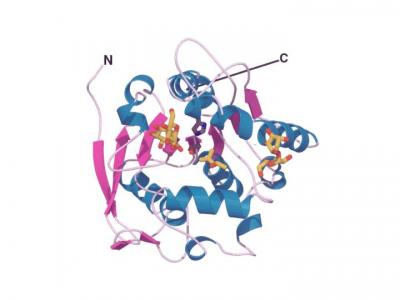New vaccine shows promise as stronger weapon against both tuberculosis and leprosy

This image depicts the structure of antigen 85B. Credit: Reproduced from Anderson et.al. , J. Molec. Biol. 307:671, 2001.
In many parts of the world, leprosy and tuberculosis live side-by-side. Worldwide there are approximately 233,000 new cases of leprosy per year, with nearly all of them occurring where tuberculosis is endemic.
The currently available century-old vaccine Bacille Calmette-Guerin, or BCG, provides only partial protection against both tuberculosis and leprosy, so a more potent vaccine is needed to combat both diseases. UCLA-led research may have found a stronger weapon against both diseases.
In a study published in the September issue of the peer-reviewed journal Infection and Immunity, the researchers found that rBCG30, a recombinant variant of BCG that overexpresses a highly abundant 30 kDa protein of the tuberculosis bacterium known as Antigen 85B, is superior to BCG in protecting against tuberculosis in animal models, and also cross protects against leprosy. In addition, they found that boosting rBCG30 with the Antigen 85B protein, a protein also expressed by the leprosy bacillus, provides considerably stronger protection against leprosy.
“This is the first study demonstrating that an improved vaccine against tuberculosis also offers cross-protection against Mycobacterium leprae, the causative agent of leprosy,” said Dr. Marcus A. Horwitz, professor of medicine and microbiology, immunology and molecular genetics, and the study's senior author. “That means that this vaccine has promise for better protecting against both major diseases at the same time.
“It is also the first study demonstrating that boosting a recombinant BCG vaccine further improves cross-protection against leprosy,” he added.
In one experiment, mice were immunized with either rBCG30 or the old BCG vaccine, or they were given a salt solution. Ten weeks later, the mice were injected with live leprosy bacteria into their footpads and seven months after that, the number of leprosy bacteria in their footpads was measured. The researchers found that the mice given BCG or rBCG30 had much fewer leprosy bacteria in their footpads than the mice given the salt solution. Additionally, mice immunized with rBCG30 had significantly fewer leprosy bacteria than those vaccinated with BCG.
In a second experiment, the mice were first immunized with BCG or rBCG30, and then immunized with a booster vaccine (r30) consisting of the TB bacterium's 30-kDa Antigen 85B protein in adjuvant — that is, in a chemical formulation that enhances the immune response. The group of mice immunized with rBCG30 and boosted with r30 had no detectable leprosy bacteria in their footpads, in contrast to groups of mice immunized with all other vaccines tested, including BCG and rBCG30 alone and BCG boosted with r30.
In other experiments, the immune responses of the mice were measured after vaccination. Mice immunized with rBCG30 and boosted with r30 had markedly enhanced immune responses to the leprosy bacterium's version of the Antigen 85B protein, which is very similar to the one expressed by the tuberculosis bacillus, compared with mice immunized with the other vaccines and vaccine combinations.
A Phase 1 human trial for rBCG30 has proven that it is safe and significantly more effective than BCG, and it is the only candidate replacement vaccine for BCG tested thus far to satisfy both of these key clinical criteria. Horwitz noted that this most recent study, however, was conducted in an animal model of leprosy, so further study is needed to gauge the effectiveness of the rBCG30 vaccine in protecting against leprosy in humans.
The next step in the research will be to test the rBCG30 vaccine for efficacy in humans against TB. If it's effective against TB, then the next step would be to test its effectiveness in humans against leprosy.
The study's co-authors are Thomas Gillis of Louisiana State University and Michael Tullius of UCLA.
Grants from the National Institutes of Health (AI031338) and the National Hansen's Disease Programs funded this study. In addition, grants from UCLA's Jonsson Comprehensive Cancer Center (P30 CA016042) and the Center for AIDS Research (5P30 AI028697) supported flow cytometry studies used to measure immune responses, and the American Leprosy Missions supported the nude mouse colony used for the propagation of M. leprae.
Media Contact
More Information:
http://www.uclahealth.org/All latest news from the category: Health and Medicine
This subject area encompasses research and studies in the field of human medicine.
Among the wide-ranging list of topics covered here are anesthesiology, anatomy, surgery, human genetics, hygiene and environmental medicine, internal medicine, neurology, pharmacology, physiology, urology and dental medicine.
Newest articles

Superradiant atoms could push the boundaries of how precisely time can be measured
Superradiant atoms can help us measure time more precisely than ever. In a new study, researchers from the University of Copenhagen present a new method for measuring the time interval,…

Ion thermoelectric conversion devices for near room temperature
The electrode sheet of the thermoelectric device consists of ionic hydrogel, which is sandwiched between the electrodes to form, and the Prussian blue on the electrode undergoes a redox reaction…

Zap Energy achieves 37-million-degree temperatures in a compact device
New publication reports record electron temperatures for a small-scale, sheared-flow-stabilized Z-pinch fusion device. In the nine decades since humans first produced fusion reactions, only a few fusion technologies have demonstrated…





















